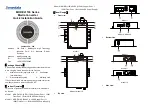
Operations and Monitoring
24
Three-wire Interface Operation
The 3-wire interface is an industry standard motor control interface. This function uses
two inputs for momentary contact start/stop control, and a third for selecting forward or
reverse direction. To implement the 3-wire interface, assign 20 [STA] (Start), 21 [STP]
(Stop), and 22 [F/R] (Forward/Reverse) to three of the intelligent input terminals. Use
momentary contact for Start and Stop. Use a selector switch such as SPST for the
Forward/Reverse input. Be sure to set the operation command selection A_02=01 for
input terminal control of motor. If you have a motor control interface that needs logic-
level control (rather than momentary pulse control), use the [FW] and [RV] inputs
instead.
Option
Code
Terminal
Symbol
Function Name
Input
State
Description
20
STA
Start Motor
ON
Start motor rotation on momentary contact (uses
acceleration profile)
OFF
No change to motor operation
21
STP
Stop Motor
ON
No change to motor operation
OFF
Stop motor rotation on momentary contact (uses
deceleration profile)
22
F/R
Forward/Reverse
ON
Select
reverse
direction of rotation
OFF
Select
forward
direction of rotation
Valid for inputs:
C_01, C_02, C_03, C_04,
C_05
Required settings:
A_02 = 01
Notes:
•
The STP logic is inverted. Normally the switch will
be closed, so you open the switch to stop. In this
way, a broken wire causes the motor to stop
automatically (safe design).
•
When you configure the inverter for 3-wire inter-
face control, the [FW] and [RV] intelligent terminal
assignments are disabled.
•
The [F/R] terminal signal level is evaluated only
when an [STA] pulse occurs.
•
You must assign both the [STA] and [STP] intelli-
gent inputs in order for the three-wire function to
work.
•
If you do not assign the [F/R] intelligent input terminal, the three-wire operation will be limited to the
forward direction only.
Example (requires input configuration—
see Chapter 3 in L100 Instruction Manual):
See I/O specs in the L100 Instruction Manual
1
2
3
4
5
L
P24
STA
F/R
STP
for
-MFR2
models
for
-MFU2
models











































